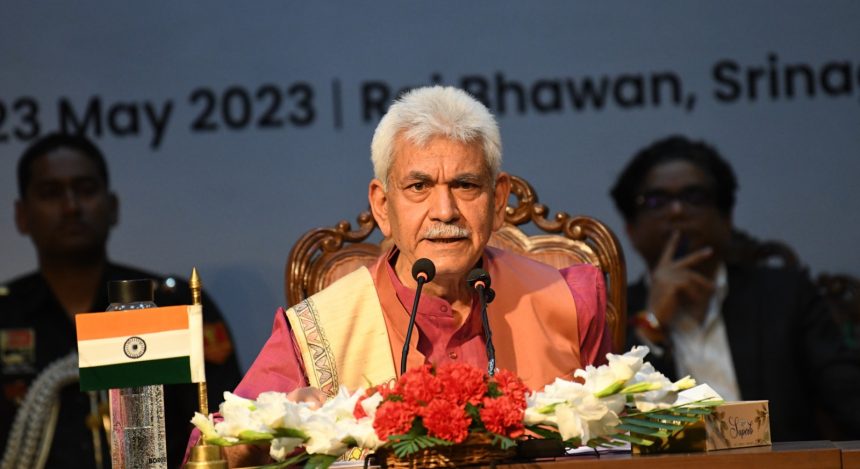The completion of five years of Lieutenant Governor Manoj Sinha’s tenure in Jammu and Kashmir offers a natural point for reflection. No Governor since Jagmohan has left as visible and defining a mark on the region’s administrative landscape as LG Sinha. Like Jagmohan, Sinha has not merely managed the day-to-day affairs of the Union Territory; he has disrupted the entrenched status quo, discarded outdated methods, and introduced an administration defined by quick decision-making, adaptability, and a refusal to be bound by old habits.
On April 22, 2025, the meadows of Baisaran near Pahalgam witnessed one of the most brutal terror attacks in recent memory. Five Lashkar-e-Taiba terrorists descended upon a group of predominantly Hindu tourists, separating men from women, demanding religious identification, and shooting at point-blank range. Twenty-six civilians were killed, and around twenty injured. The attackers carried AK-47s and M4 carbines, symbols of Pakistan’s continuing sponsorship of bloodshed.
The Pahalgam attack unleashed a storm of questions: Was there a gap in security planning? How deep does the terror network still run? Is intelligence-sharing adequate? The public was bracing for the usual bureaucratic evasions. Instead, Manoj Sinha took the podium and did something rare. He accepted full responsibility, calling it a “security failure.” It was a remarkable departure from the standard blame-shifting. In Sinha’s worldview, it is better to try and fail than to never have tried at all.
The attack cannot be seen in isolation. Yes, there were operational lapses, but the political backdrop is equally relevant. Reckless statements by local politicians and the absence of a united, unequivocal political stand against Pakistan-sponsored terrorism have created cracks that adversaries exploit. That deeper discussion, perhaps, belongs to another day.
Yet, Pahalgam must also be seen against a much broader canvas. In the past five years, the streets of J&K have been quieter than at any time since the 1990s. Gone are the days when separatist “calendars” dictated shutdowns, when stone pelting was an everyday hazard, and when Pakistan’s proxies could shut down education and commerce at will. Schools and colleges now function year-round. There was a time when educational institutions were torched as acts of anti-India messaging; today, they are full of students.
While some terror incidents in Jammu and Kashmir have occurred, the perpetrators are overwhelmingly Pakistani terrorists. Local recruitment into terror ranks is almost nil, a testament to the collapse of Pakistan’s indoctrination network in the Valley. This is not accidental. This shift is the result of a massive reduction in Pakistan-backed indoctrination in the Valley, coupled with the de-hyphenation of Pakistan from Kashmiri mindset. Increasingly, young Kashmiris see their future in the idea of India rather than in the failing state of Pakistan. Development, transparency, and accountability have become more persuasive than the hollow promises of a bankrupt neighbour.
The numbers from the 2024 General Elections tell their own story. J&K recorded a combined turnout of 58.46%, the highest in 35 years. In the Valley, participation jumped from a dismal 19.16% in 2019 to 50.86% in 2024, a seismic shift in democratic engagement. For the first time in decades, the ballot seemed more powerful than the bullet.
From the outset, Sinha’s mission was to wrest the initiative from subversive forces and restore the authority of the state. He drew a straight line of action, rooted in resolve, bolstered by administrative innovation, and sustained by pressure on separatist structures. Unlike many predecessors, he refused to allow malignant trends to fester. The old Kashmir malaise, where terrorists and separatist sympathisers thrived in government jobs, where bar associations were hijacked by anti-India interests, and where patronage enriched only a few hundred entrenched families, was confronted head-on.
Perhaps Sinha’s most human intervention was his acknowledgment of the victims of Pakistan-backed terror. For decades, countless civilians killed by terrorists were ignored, their stories erased from public memory. FIRs were never filed, properties were seized, and families lived in silence while their tormentors were glorified. Sinha publicly apologised for the state’s long neglect, reopening cases, restoring property, offering compensation, and providing jobs to over 350 such victims in just last two months.
Development statistics over the past five years are staggering. The GDP of J&K has doubled from ₹1.17 lakh crore in 2017 to ₹2.45 lakh crore in 2023-24. J&K Bank has gone from a ₹1,139 crore loss in 2019-20 to a ₹1,700 crore profit in 2023-24, with NPAs halving. Government revenues have surged by 48% since 2019, and exports of handloom and handicrafts have more than doubled. Tourism has touched record highs, with 2.11 crore visitors in 2023 and foreign arrivals up 300%. Even the Pahalgam attack could not dent the tourism surge or the Amarnath Yatra in 2025. Just days ago, a record 4.12 lakh pilgrims completed the yatra peacefully.
Social welfare measures have reached previously untouched sections. Housing for 2.15 lakh poor families, land to 477 landless households under PMAY, and near-universal health coverage under AB-PMJAY SEHAT have changed lives. Over 85.5 lakh golden cards have been issued, enabling ₹2,334 crore worth of free treatment. The healthcare landscape now includes AIIMS Jammu (inaugurated), AIIMS Kashmir (to be completed by late 2025), two State Cancer Institutes, and two new Bone & Joint Hospitals. Education, too, has seen a boom. Jammu is now the only Indian city to host an IIT, IIM, AIIMS, IIMC, and a Central University, supported by 51 new degree colleges.
The most profound change, however, may be psychological. In the past, Pakistan’s proxies could shut down the Valley with a call; today, its terrorist outrages draw protests from the same streets. As a journalist, I recently heard a Kashmiri in Pahalgam say openly on my camera that if these terrorists of Baisaran attack came before him, he would burn them alive, a statement unimaginable a decade ago.
Contrast this with the pre-2019 era, when every other day brought news of civilian deaths in street clashes, and central funds vanished into the black hole of family rule politics. Today, governance is less about patronage and more about performance. Both the Modi government at the Centre and Sinha’s administration and security apparatus in J&K have introduced accountability and transparency into the DNA of the system.
The Pahalgam tragedy remains a scar, but it is not the defining story of Sinha’s tenure. His five years have been defined by a rare mix of firmness and empathy, by the ability to wield state power against those who threaten peace, while also extending a hand to those the state once ignored.
The road ahead will still have dangers, but five years in, one thing is clear. The old rules no longer apply. And that, in itself, is a revolution.
(The Author is a prominent journalist based in Srinagar. He has contributed to several leading national news outlets)









